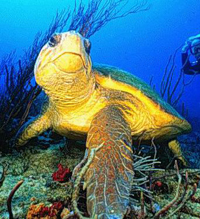Draft Revised Recovery Plan for the Northwest Atlantic Loggerhead Sea Turtle Available for Review
May 30, 2008
NOAA’s Fisheries Service and the U.S. Fish and Wildlife Service (USFWS) are seeking public input on the draft revised recovery plan for the northwest Atlantic population of the Loggerhead Sea Turtle (Caretta caretta). The species is listed globally as threatened under the Endangered Species Act.
“This is an important next step in the conservation and recovery of the loggerhead turtle,” said Jim Balsiger, acting assistant administrator for NOAA’s Fisheries Service. “What we’ve done is identify threats, and provide a blueprint for addressing these threats in order to recover loggerhead turtles. These actions are important and necessary.”
The draft revised plan reviews and discusses the species ecology, population status and trends, and identifies threats to the loggerhead turtle in the northwest Atlantic. It lays out a recovery strategy to address the threats, based on the best available science, and includes recovery goals and criteria. In addition, the plan identifies substantive actions needed to address the threats to the species and achieve recovery.
An initial recovery plan for the loggerhead turtle was approved on September 19, 1984. This initial plan was a multi-species plan for all six species of sea turtles occurring in the U.S. On December 26, 1991, a separate recovery plan for the U.S. Atlantic population of the loggerhead turtle was approved. In 2001, NOAA’s Fisheries Service and USFWS, which share regulatory jurisdiction for sea turtles, initiated the process to revise the loggerhead plan for a second time.
This revised plan is significant in that it identifies five unique recovery units, which comprise the population of loggerhead turtles in the northwest Atlantic, and describes specific recovery criteria for each recovery unit.
Loggerhead turtles in the northwest Atlantic mature to reproductive age at about 35 years. During their lifetime, they travel and live in the waters of several nations, including the U.S. They face many challenges and threats, including development and loss of nesting habitat, bycatch in fisheries and degradation of their marine habitats. The recovery of any species takes time, but scientists say that for the loggerhead turtle it could take even longer due to the long time to reach maturity and the variety and magnitude of the threats they face.
“Recovery of loggerhead turtles in the northwest Atlantic is a long-term effort that requires cooperation from various groups,” said Bryan Arroyo, USFWS assistant director for endangered species. "It will take commitment and coordination from federal, state, and local government agencies, local communities, conservation organizations, and industry groups, as well as international cooperation.”
Agencies will accept public comments for 60 days until July 29, 2008.
Please send comments about the draft revised recovery plan for the northwest Atlantic population of the Loggerhead Sea Turtle by any one of the following methods:
E-Mail to seaturtle@fws.gov. Include in the subject line “Comments on Northwest Atlantic Loggerhead Recovery Plan.” Attachments to electronic comments will be accepted in Microsoft Word, Excel, WordPerfect, or Adobe PDF file formats only.
Mail:
National Marine Fisheries Service National Sea Turtle Coordinator
Attn: Draft Loggerhead Recovery Plan
Office of Protected Resources
National Marine Fisheries Service
1315 East-West Highway, Room 13657
Silver Spring, MD 20910or
USFWS National Sea Turtle Coordinator
U.S. Fish and Wildlife Service
6620 Southpoint Drive South, Suite 310
Jacksonville, FL 32216Fax to 301-713-0376, Attn: National Marine Fisheries Service National Sea Turtle Coordinator.
The public can review the plan online at http://www.fws.gov/northflorida/SeaTurtles/loggerhead-recovery/default-loggerhead.htm or http://www.nmfs.noaa.gov/pr/recovery/plans.htm
NOAA’s Fisheries Service is dedicated to protecting and preserving our nation’s living marine resources and their habitat through scientific research, management and enforcement. NOAA’s Fisheries Service provides effective stewardship of these resources for the benefit of the nation, supporting coastal communities that depend upon them, and helping to provide safe and healthy seafood to consumers and recreational opportunities for the American public.
The mission of the U.S. Fish and Wildlife Service is working with others to conserve, protect and enhance fish, wildlife, plants and their habitats for the continuing benefit of the American people. We are both a leader and trusted partner in fish and wildlife conservation, known for our scientific excellence, stewardship of lands and natural resources, dedicated professionals and commitment to public service.
The National Oceanic and Atmospheric Administration, an agency of the U.S. Commerce Department, is dedicated to enhancing economic security and national safety through the prediction and research of weather and climate-related events and information service delivery for transportation, and by providing environmental stewardship of our nation's coastal and marine resources. Through the emerging Global Earth Observation System of Systems (GEOSS), NOAA is working with its federal partners, more than 70 countries and the European Commission to develop a global monitoring network that is as integrated as the planet it observes, predicts and protects.

